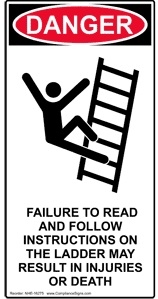Superstitions often have rational roots. While some superstitions just seem silly — like Friday the 13th being unlucky or a bird pooping on you being lucky — the one about walking under a ladder being unlucky makes sense. It wasn’t safe a few hundred years ago when the belief originated and it’s not safe now.
Don’t walk under a ladder
A few centuries ago, when people drank at lot of ale at lunch, they were warned against passing under ladders during the day when drunken sign painters might drop buckets of paint or tools on them.
Drunk or sober, the person on the ladder is paying attention to what they are doing, not to the traffic below. Passing between the legs of a ladder or near it poses a risk for both parties — the person perched on top who could be knocked off their perch and the passerby who could have something dropped on them.
Use a ladder when warranted, not something else
So, there’s something on the top closet shelf you want and it’s just out of reach. Seems so easy to just grab the kitchen chair and stand on it to gain that extra six inches. Don’t. You’re getting the kayak up on top of the car and can’t quite reach the strap and that garden bucket is just the right height. Resist! Chairs and buckets and other household objects are not designed to be stood upon. These objects may be unstable or too weak to support your weight, leading to a fall. Take the extra few minutes to get a proper ladder for the job at hand and avoid a trip to the ER.
Painful stats
Now that we’ve established the need to use a ladder, here’s something to consider:
According to the Consumer Product Safety Commission, more than 90,000 people receive emergency room treatment from ladder-related injuries every year.
The United States Department of Labor reports falls from portable ladders are one of the leading causes of occupational fatalities and injuries (that’s 15 percent of all occupational deaths).
There is a right way to use a ladder

Whether you need to reach something on a high shelf, clean a gutter, hang decorations or paint a tall wall, using a ladder can be necessary. However, it needn’t be dangerous. There are guidelines which should be followed to ensure the safest possible experience — many of them printed right on the ladder
- Read and follow all labels/markings on the ladder. They are there for reason, mostly to keep you from getting hurt!
- Avoid electrical hazards – look for overhead power lines before handling a ladder. Avoid using a metal ladder near power lines or exposed energized electrical equipment.
- Inspect the ladder prior to using it. If the ladder is damaged, don’t use it.
- Maintain a 3-point contact (two hands and a foot, or two feet and a hand) on the ladder when climbing. Keep your body near the middle of the step and always face the ladder while climbing.
- Use ladders only for designed purpose.
- Keep ladders free of any slippery material on the rungs, steps or feet.
- Do not use a self-supporting ladder in a partially closed position.
- Do not use the top step/rung of a ladder as a step/rung unless it was designed for that purpose.
- Use a ladder only on a stable and level surface.
- Do not place a ladder on boxes, barrels or other unstable bases to obtain additional height.
- Do not move or shift a ladder while a person or equipment is on the ladder.
- An extension or straight ladder used to access an elevated surface must extend at least 3 feet above the point of support. Do not stand on the three top rungs of a straight, single or extension ladder.
- The proper angle for setting up a ladder is to place its base a quarter of the working length of the ladder from the wall or other vertical surface (see diagram).
- Be sure that all locks on an extension ladder are properly engaged.
- Do not exceed the maximum load rating of a ladder.
Even when we use all necessary precautions, accidents involving ladders may occur. When they do, and you experience persistent bone or joint pain as a result, get a professional evaluation. The surgeons of Great Basin Orthopaedics have the skill and expertise to diagnose and treat fall injuries and all their patients see a doctor at every visit. To make an appointment, call 775.786.1600.